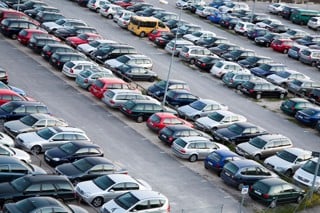The loss of the hard shoulder means that more than half (56%) of motorists would carry on driving with a flat tyre until they reached an emergency refuge area or the next motorway exit, according to the AA.
With spacing between emergency refuge areas extended from 800m on the M42 pilot scheme to a new standard of up to 2500m, cars could be limping along for up to 1.5 miles in fast traffic.
The AA Populus research among 19,887 AA members (November 2014) also found that drivers are willing to ignore closed lanes with 10% of drivers surveyed seeking to take advantage of an empty first lane.
Despite ‘red X' signs telling them to stay out of the lane, 3% would continue in the closed lane until they saw an incident ahead and 3% would go into the outer lane but move back in if others did and were moving more quickly. A further 3% would stay in the closed lane until they encountered another ‘red X' sign - women being twice as likely to do this as men.
Faced by the daily battle on the motorway, 14% of Londoners and 12% of AA members in the South East would ride their luck in a closed motorway lane. In particular, waiting until they can actually see the incident ahead.
This new research comes after Government road casualty statistics revealed that, although there are fewer motorway accidents involving back-seat passengers, those passengers are more likely to be killed.
There were almost seven times fewer injuries to back seat passengers in motorway crashes last year, but one in 120 died as opposed to one in 150 sitting in the front. This is a pattern that has been consistent for at least the past four years.
The AA has voiced its concern about the safety of all-lane-running motorways from the start. The speed with which a dangerous situation can be identified, located and the lane closed, as well as an insufficient number of ‘emergency refuge areas', leaves vehicles vulnerable to almost entirely rear-end impacts.
The AA has been obliged to adapt its breakdown procedures to protect its members along these routes: calls for breakdown assistance now involve the motorway authorities directly in a three-way conversation to locate and manage the incident as quickly and effectively as possible. As well as the ability to locate most breakdowns by triangulating mobile phone calls (with the member's permissions), the AA smart phone app can link directly to the phone's GPS tracker and pinpoint the breakdown.
"It is a sad fact that there are many incidents of vehicles being hit when stationary on the hard shoulder. When a vehicle is broken down in a live running lane the red ‘X' is a potential life saver," says Edmund King, the AA's president.
"Drivers who ignore the red ‘X' are not only putting themselves and the lives of other motorists around them at risk but are also risking prosecution. While some motorists may feel a red ‘X' is being incorrectly shown, this does not mean they can ignore them. A slight delay in their journey is nothing compared to the danger they are putting others in by ignoring these instructions which are critical to the safe operation of ‘Smart' motorways".
King added: "The AA applauds the Government's move to increase motorway capacity - but it can't be done on the cheap by skimping on safety features. Emergency refuge areas may add to the cost but drivers are more likely to try to get their stricken vehicles into the next safe haven if they know it's close. Not only does that make the highway considerably safer, but it keeps the traffic flowing - which is the whole point of all lane running.
"We soon spotted the safety compromises and worked quickly to try to protect our members on these more hazardous stretches of motorway. However, long-established safety procedures for motorway breakdowns where a hard shoulder is present need to be updated for when there isn't one. There should be no doubt in drivers' and their passengers' minds as to what they should do when a car breaks down on a motorway without a hard shoulder."
The AA welcomes the Highways Agency's recent use of variable message signs to remind drivers of the importance of observing the ‘red X' sign.




















John Blair - 13/02/2015 11:36
Removal of HGV from motorway at peak times 6-9am and 5-6pm would increase traffic flow considerably in my opinion